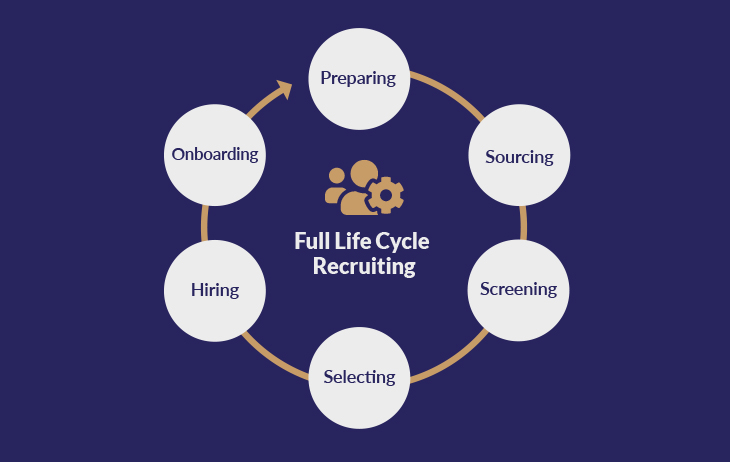Topics: Full Cycle Recruiting, full life cycle recruiting process, life cycle recruiting, Recruitment Strategy
The Key Elements of a Successful Full Cycle Recruiting Strategy
Posted on August 29, 2024
Written By Ranjana Singh

Recruiting isn’t just about posting a job and waiting for candidates to apply. Imagine this: you’ve posted a job, received a pile of applications, but only a few are worth considering. Frustrating, right? A poor hiring process can waste time, drain resources, and leave you with unfilled positions. That’s why you need a well-thought-out full cycle recruiting strategy.
A good full cycle recruitment process is like a roadmap that guides you through every step of the hiring process, ensuring you attract, engage, and hire the best talent. In today’s competitive job market, it’s crucial to go beyond traditional recruiting methods. A comprehensive strategy impacts hiring quality, boosts productivity, and helps build a strong team that drives your business forward.
Outsourcing your full cycle recruitment process can be a game-changer, making your recruiting efforts more efficient and even save you costs. Before you explore offshore recruitment services, let’s dive into the key elements of a full cycle recruiting strategy that can help you attract top talent and grow your business.
What are the Main Elements of a Successful full cycle recruiting Strategy

1. Positive Candidate Experience
Imagine you’re a candidate applying for a job. How would you feel if you were left in the dark about your application status? Not good, right? A positive candidate experience is crucial. The recruiting process is a two-way street. While you’re evaluating candidates, they’re also evaluating your company.
To ensure a positive experience, keep communication clear and timely. For example, if a candidate applies for a job, promptly acknowledge their application. Provide detailed information about the role, salary expectations, and career growth. During the process, keep them updated on their status and provide feedback after interviews. This approach not only increases the chances of offer acceptance but also builds a strong talent pipeline, even for future openings.
2. Employer Branding
Think about why you’d want to work for a specific company. Often, it’s not just about the job itself but the company’s reputation. Your employer brand is crucial. A strong brand attracts top talent because people want to work for reputable organizations that align with their values.
Showcase why your company is a great place to work. Highlight employee benefits, work culture, and any unique perks. For example, if you offer flexible working hours or professional development opportunities, make sure potential candidates know about it. A strong employer brand helps candidates see why they should choose your company over others.
3. Sourcing and Screening
Don’t just wait for candidates to find you—go out and find them. Proactive sourcing is key. Use different channels like social media, professional networks, and employee referrals. If you don’t have the resources, consider using offshore recruiting companies. They have wide networks and can help find the best talent quickly.
Once you have candidates, the next step is screening. Use an Applicant Tracking System (ATS) to manage resumes and applications. This system helps you keep track of candidates and maintain communication with them. For instance, if you’re looking for a software developer, screen for relevant skills, experience, and education to find the best fit.
4. Workforce Planning
Planning your workforce needs is like planning a trip. You need to know where you’re going and what you’ll need along the way. Identify your long-term and short-term hiring needs and regularly analyze your employee base. This helps you make better decisions and prioritize resources.
For example, post-COVID-19, many companies adopted remote work. If remote work suits your business, plan your hiring strategy to include remote candidates. This flexibility can improve employee retention and attract a wider pool of talent.
5. Using Different Selection Methods
Selecting the right candidate involves more than just a resume review. Use various methods to assess candidates thoroughly. Start with initial screening, which might include looking at portfolios or answering application questions. Then, use interviews, aptitude tests, and work samples to evaluate skills and competencies.
For example, if you’re hiring a marketing manager, you might ask them to present a marketing plan or complete a writing test. These methods help ensure you find the best fit for the role.
6. Efficient Onboarding Process
Once you’ve selected the right candidate, the onboarding process is critical. A well-structured onboarding process ensures that new hires feel welcomed and are quickly integrated into the team. This phase includes everything from initial paperwork to training and mentoring.
For example, set up a buddy system where a current employee helps the new hire navigate the company culture and procedures. Effective onboarding can lead to higher job satisfaction, faster productivity, and improved retention rates.
7. Continuous Candidate Engagement
Even after hiring, maintaining engagement with candidates can be beneficial, especially for future hiring needs. Create talent pools of previous candidates who were a good fit but didn’t make it through the final selection.
Stay in touch through newsletters, social media, or occasional updates about the company. This keeps your company top of mind for future opportunities and can shorten the hiring process next time around.
8. Data-Driven Decision Making
Using data to inform recruitment decisions can significantly improve outcomes. Track metrics such as time-to-hire, cost-per-hire, and quality of hire. Analyze this data to identify bottlenecks in your recruitment process and areas for improvement.
For instance, if your data shows that a particular job board consistently produces high-quality candidates, you can allocate more resources there. Data-driven decisions help streamline the recruitment process and make it more effective.
9. Diversity and Inclusion Initiatives
In today’s global market, a diverse workforce is a strong workforce. Implementing diversity and inclusion initiatives in your recruitment process ensures that you attract a wide range of candidates with different perspectives and ideas.
For example, create unbiased job descriptions, ensure diverse interview panels, and actively source candidates from underrepresented groups. This not only promotes a positive company culture but also enhances creativity and problem-solving within teams.
10. Ongoing Training and Development
Recruitment doesn’t end when the candidate is hired. Continuous learning and development opportunities are essential for keeping employees engaged and motivated. Provide regular training sessions, workshops, and career development programs to help employees grow within the company.
For example, offer courses on leadership, technical skills, or soft skills like communication. Investing in your employees’ growth shows that you value them, which can lead to increased loyalty and reduced turnover.
Conclusion
We hope you enjoyed this guide on the key elements of a successful full cycle recruiting strategy. QX Global Group, a leading provider of offshore recruitment processes, offers tailored full life cycle recruiting services to enhance the entire talent acquisition process. Our output-focused and insight-driven services help staffing agencies reduce cost and time to hire, lower attrition rates, and increase productivity. By adopting this method, recruiters can align with long-term organizational goals, save time and costs, and focus on core business practices.
Book a Free Consultation
Enjoyed our blog? Discover more about how our recruitment outsourcing process can slash your costs by up to 60%! Take the next step—book a call by entering your details.
Originally published Aug 29, 2024 07:08:19, updated Feb 17 2025
Topics: Full Cycle Recruiting, full life cycle recruiting process, life cycle recruiting, Recruitment Strategy







